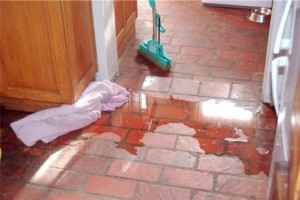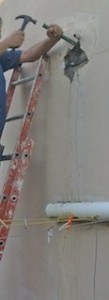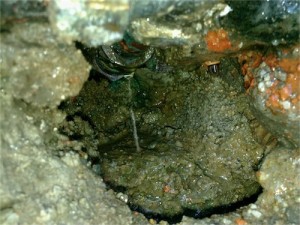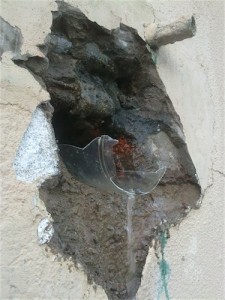Plumbing Problems
Burst Pipe Plumbing Problems can Result in Water Water Everywhere
It was a case of water, water everywhere and not a drop to drink recently when a burst pipe began to flood our rented home.
Tensions were high as water dribbled out from under the fridge. Another appliance was clearly about to give up the ghost! The bad news was that it’s the “best” of our three fridges, having been transferred from my mother-in-law’s Howick house only a year ago. We have one almost identical, but it’s changed its function to a full-on freezer. The replacement we bought when this happened some years ago is falling to pieces – literally, chip by chip. When the door disintegrates just a little more, we’ll be back in the fridge market yet again. So this was not good news.
What Happens When Water Leaks
Water has a devious nature, even when homes have been built according to building regulation requirements. It quite literally goes with the flow. The problem is that it is often impossible to assess the origin of the flow. That is why leaks can be such a huge problem.
In this case, it seemed to be flowing from the fridge. But then on second thoughts, it looked as if it was coming from under a kitchen unit installed opposite the fridge. The entire bank of units is nearly 3 m long and runs from steps that lead down from a guest loo that is located behind the kitchen, alongside the scullery.
Knowing that the house – or at least part of the house extension – was constructed without building plans, we figured it was quite possible that the water was coming from the cloakroom (so to speak). The fact that water was seeping out at both ends of the kitchen units seemed to confirm our suspicions.
Of course, the know-all matriarch knew exactly what was going on!
“Your fridge is leaking badly!” she said on Day One… “It’s your fridge actually,” I pointed out.
Hearing chatter of a possible burst toilet or faulty water pipe a couple of days later, she pronounced: “Look, the toilet is leaking.”
“Actually no! It’s neither the fridge nor the toilet!” As I said, water is devious.
By this time I had done a simple experiment using a towel and a sponge mop and had ascertained that the flow was definitely from the direction of said fridge. The water that was seeping out the other end had reached its final destination.
I had also defrosted the fridge. Next, we had to move the fridge. It was wet on the floor where the fridge had been, and the water seemed to be coming from the corner. My 21-year-old computer genius son was called in to help find the source. Since the inside floor of the cupboard just inside the scullery was already rotten to the core when we moved into the house – clearly due to flooding and probably due to burst pipes – he went to investigate the outside wall where he spotted water pouring from who-knows-where!
All we could do to stop the leaking water was to switch off the water supply to the house and hope that the owner’s agent would act immediately… which she did, though it only resulted in a temporary solution.
Plumbers and the Regulations
First of all, the National Building Regulations are VERY specific when it comes to plumbers and plumbing work. You’ll find the relevant clauses in Part A, Administration, A18 CONTROL OF PLUMBERS AND PLUMBING WORK.
It is clear as daylight that “No person shall perform the trade of plumbing … unless he is a trained plumber or works under the adequate control of a trained plumber or approved competent person.”
While the reasons are irrelevant when it comes to those who blatantly break the law by using untrained, unregistered people to do plumbing installations and repairs, the fact of the matter is that plumbing is one of the most expensive parts of any building process (if it isn’t then there’s something very wrong). Furthermore, if the proper procedures aren’t followed, people’s lives can be adversely affected in terms of health, injury and/or damage to property. However, it would probably be difficult to hold a landlord liable because most lease agreements contain clauses that absolve him or her from all responsibility – even if it was in fact their fault.
So when a plumbing installation is done, plumbers have to use materials that have been approved by the South African Bureau of Standards (SABS) and work correctly according to the National Building Regulations and various South African Nations Standards (SANS). Drainage installations must be tested by inspectors who work for the local authority before we are permitted to use the drains. Most local authorities also inspect all trenches and excavations before drains can be laid. They also insist that all plumbing and drain-laying is done, or overseen, by a qualified plumber who is registered with the Institute of Plumbing South Africa (IOPSA).
For the record, a trained and qualified plumber is defined in South Africa as an apprentice who has passed a Department of Labour plumbing trade test or a plumber who has a national certificate in construction plumbing at NQF Level 3. But even if somebody passes the required trade test or national certificate, they cannot claim to be a legit plumber unless they are registered with IOPSA. The reason for this is perfectly simple: to make sure that all plumbing work is done safely, in the proper way, and according to industry standards.
If plumbing is done correctly in the first place, maintenance issues will be minimized and we should all live happily ever after.
Plumbers and Our Rented Property
I have previously described a couple of the very many leaks we have experienced in the past 16 months. The horrifying fact is that owners of the property (past and present) have clearly ignored the law!
I discovered just the other day that renovations completed by the current owner include two bathrooms that don’t incorporate a septic tank in the (unofficial) building plans. Furthermore the “builder” who isn’t a builder in the real sense of the word, was also employed to do the plumbing! When a registered plumber was called in, he refused to do the job unless a septic tank was built or installed. Needless to say he did not accept the job.
While not related to plumbing directly, this same builder sealed one section of a roof from the inside! Seriously… I dare not even think what would happen if these particular bathrooms were used on a continuous basis.
But back to the most recent leak that affects our home.
On the positive side, someone was on site within two hours of us notifying the agent of the problem. I was assured that he knew the property. This puzzled me since it was a new name.
Funny how people can twist the “truth”. It turned out that he had never set foot on the property, but had a close relative who had worked for the dodgy “builder”. I cannot repeat what was said about the renovation-come-build because it appears a court case is pending!
The Leak Revealed
Having tracked the source of the flooding water to a corner of the kitchen, we were able to help the new (to us) plumbing expert find out where the leak was. It wasn’t too difficult since the water was pouring out on the outside at a position that coincided with what was clearly a poly-filled track down the wall for several metres, close to the geyser outlet pipe.
Turns out he, like my son, is in IT. Plumbing? Don’t be silly!












Hi Penny
when was copper pipes first used in water supply line in residence
Hi, I have replied 🙂
Sent an email asking for advice.
to date no reply.
Polycop pipes (made from a type of polypropylene material) were never intended to be used for hot water, but it is still used for cold water. So you’re fine. Prior to Polycop galvanized steel pipe was used for cold water. A newer alternative is Cobra multi-layer pipe for hot and cold water, as long as where the hot water cylinder is attached, there is at least 1 m of copper pipe.
BTW these standards are not covered by the National Building Regulations but rather by SANS 10252-1:2012 Water supply and drainage for buildings Part 1: Water supply installations for buildings
5.2 Pipes and pipe fittings
NOTE 1 Piping materials used for water installations in buildings include, but are not limited to galvanized mild steel, copper, stainless steel, polypropylene, polyethylene, cross-linked polyethylene, PVC-U, chlorinated PVC, Poly butylene, PVC-M and PVC-O.
NOTE 2 Metals and metal alloys (such as copper and stainless steel) that rely on the presence of protective surface films for their corrosion resistance are particularly prone to pitting corrosion under unfavourable conditions.
NOTE 3 Where galvanized mild steel pipes and copper pipes are used in the same system, the corrosion rate of galvanized steel is usually substantially increased by the traces of copper present in the water. Dissolved copper ions can stimulate the corrosion of zinc coatings and bare steel surfaces, either by direct electrochemical exchange reactions or by galvanic attack. Dissolved copper is, however, usually only found in cases where galvanized mild steel hot water outlet pipes are used together with copper domestic water heaters that operate at excessively high temperatures.
NOTE 4 Where galvanized mild steel pipes and copper pipes are to be used in the same system especially at temperatures in excess of 60 °C, the copper pipe should be downstream of the galvanized steel pipe.
5.2.3.1 (second para)
All SANS standards for plastic polymer piping system for hot and cold water supplies are approved for use inside buildings only. All plastics pipes used in hot and cold water installations near external doorways and windows, shall be protected from sunlight. Unlike metal pipes (steel and copper) that have generic pipe and fitting standards, thermoplastic pipe systems are required to be installed using the fittings and tools that are tested and approved as a complete system, The use of pipes, fittings and tools from other manufacturers or suppliers, that are not the same as the approved system, shall not be acceptable.
Let me know if you need any more info.
I’ve recently had my geyser replaced. The geyser is situated in my roof-space.
The water pipes were all polycarp, however, I’ve had the hot water piping network replaced with copper pipes some years ago, so what is remaining is polycarp on the cold water side.
The plumbing contractor is now wanting to replace all the polycarp with copper pipes, (in the roof-space) as he claims it is compulsory for it to be copper. I have searched this site, but could not find any reference to polycarp vs copper.
Could you please shed some light on this, would be highly appreciated.
Peter
Working in government as a qualified plumber.why can’t PIRB compel plumbers to register ones qualify?
Rudolf, how do they address the situation when the plumber is NOT actually a plumber? As in our experience, the plumber (who was ironically better than most of the other supposedly qualified plumbers who had been called in) was openly a man who worked in the IT industry. That is downright illegal!
Dear Raoul
Contact a Plumbing Industry Registration Board (PIRB) inspector in your region, to come and advise you. He will most probably cite the plumber for illegal work done on your apartment.
I have bought a unit in a sectional title complex and I am having problems with the plumbing installation at the complex. When the unit was handed over to me I complained about sewerage stench in my bathroom, I was told that the system is new and the smell will go away in the foreseeable future.
I have occupancy for two and a half years and the smell still exists. Recently I have discovered what the problem is after my tenant complained about noises in the ceiling which she attributed to rodents. I had a pest control company inspect the flat and to my disbelief they told me that there is no rodents or pests in the ceiling but that the noise is coming from a sewerage pipe running across my ceiling and then down the corner of the main bedroom behind the cupboard, further he tells me that the sewerage gasses are vented from the pipe into my ceiling. Surely this contravenes the health and safety act. I have reported the matter to the body corporate and they tell me that they cannot do anything about it and that I should contact the builder myself.
Before I contact the builder I would like to know if this is standard practice or accepted by regulations that a waste pipe may traverse one’s ceiling and that the sewerage gasses may be vented into the ceiling. If the building regulations have been transgressed, what recourse I have?.
I find it strange that we pay all sorts of taxes so that we can be protected from being ripped off but it still happens. The building inspector should have condemned it and the building plans should never have been passed.
Can someone please advice on this issue?